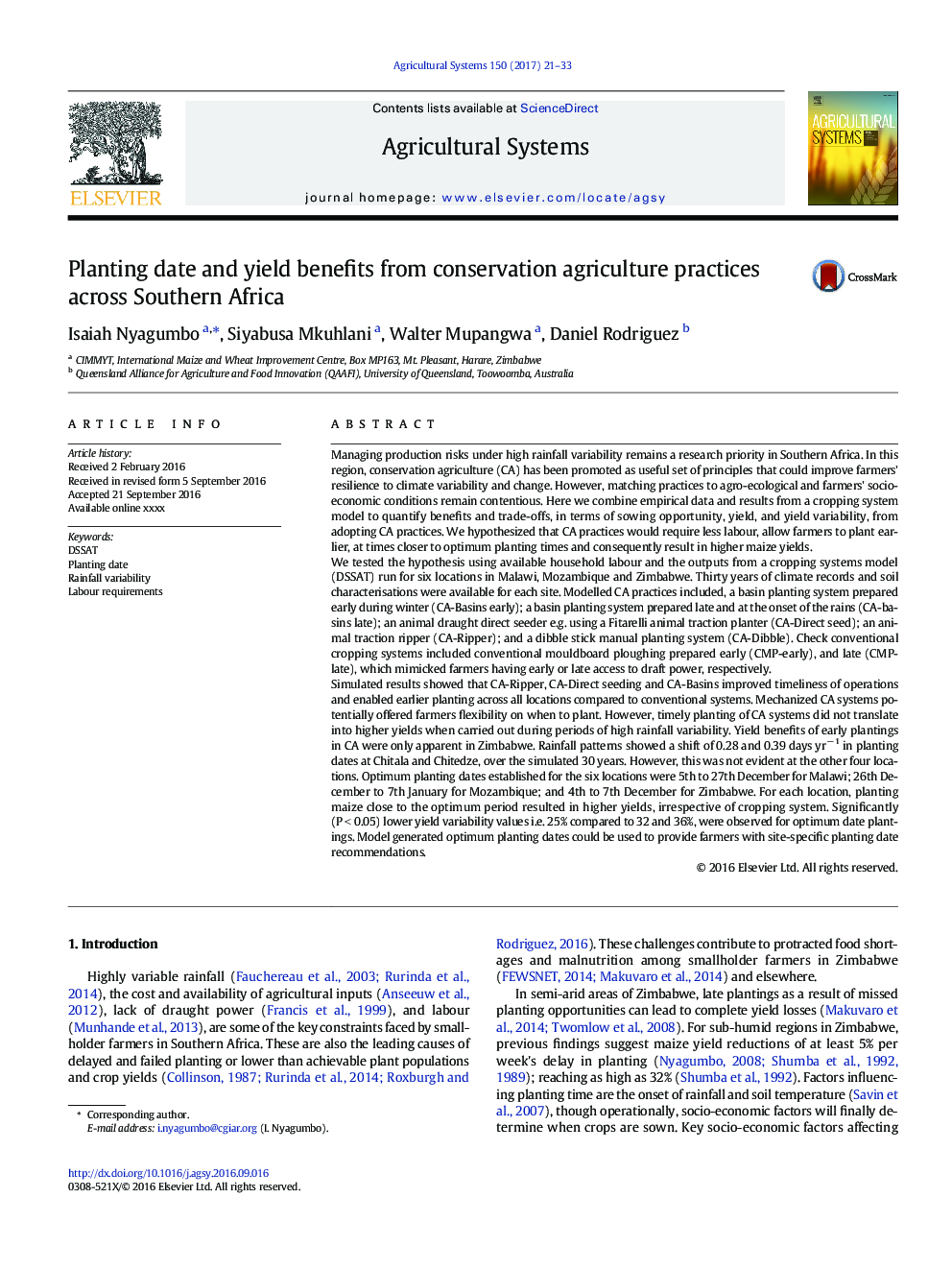| کد مقاله | کد نشریه | سال انتشار | مقاله انگلیسی | نسخه تمام متن |
|---|---|---|---|---|
| 4491103 | 1623220 | 2017 | 13 صفحه PDF | دانلود رایگان |
• Mechanized CA systems (direct seeders and rippers) improve planting timeliness.
• Winter prepared manual CA basin systems also improved timeliness of planting.
• Yield benefits of timely planting apparent during low rainfall variability periods.
• Optimum planting dates delayed by 0.28 to 0.39 days yr− 1 in Malawi in the 30 years.
• Planting during optimum periods lowered (P < 0.05) maize yield variability.
Managing production risks under high rainfall variability remains a research priority in Southern Africa. In this region, conservation agriculture (CA) has been promoted as useful set of principles that could improve farmers' resilience to climate variability and change. However, matching practices to agro-ecological and farmers' socio-economic conditions remain contentious. Here we combine empirical data and results from a cropping system model to quantify benefits and trade-offs, in terms of sowing opportunity, yield, and yield variability, from adopting CA practices. We hypothesized that CA practices would require less labour, allow farmers to plant earlier, at times closer to optimum planting times and consequently result in higher maize yields.We tested the hypothesis using available household labour and the outputs from a cropping systems model (DSSAT) run for six locations in Malawi, Mozambique and Zimbabwe. Thirty years of climate records and soil characterisations were available for each site. Modelled CA practices included, a basin planting system prepared early during winter (CA-Basins early); a basin planting system prepared late and at the onset of the rains (CA-basins late); an animal draught direct seeder e.g. using a Fitarelli animal traction planter (CA-Direct seed); an animal traction ripper (CA-Ripper); and a dibble stick manual planting system (CA-Dibble). Check conventional cropping systems included conventional mouldboard ploughing prepared early (CMP-early), and late (CMP-late), which mimicked farmers having early or late access to draft power, respectively.Simulated results showed that CA-Ripper, CA-Direct seeding and CA-Basins improved timeliness of operations and enabled earlier planting across all locations compared to conventional systems. Mechanized CA systems potentially offered farmers flexibility on when to plant. However, timely planting of CA systems did not translate into higher yields when carried out during periods of high rainfall variability. Yield benefits of early plantings in CA were only apparent in Zimbabwe. Rainfall patterns showed a shift of 0.28 and 0.39 days yr− 1 in planting dates at Chitala and Chitedze, over the simulated 30 years. However, this was not evident at the other four locations. Optimum planting dates established for the six locations were 5th to 27th December for Malawi; 26th December to 7th January for Mozambique; and 4th to 7th December for Zimbabwe. For each location, planting maize close to the optimum period resulted in higher yields, irrespective of cropping system. Significantly (P < 0.05) lower yield variability values i.e. 25% compared to 32 and 36%, were observed for optimum date plantings. Model generated optimum planting dates could be used to provide farmers with site-specific planting date recommendations.
Journal: Agricultural Systems - Volume 150, January 2017, Pages 21–33
